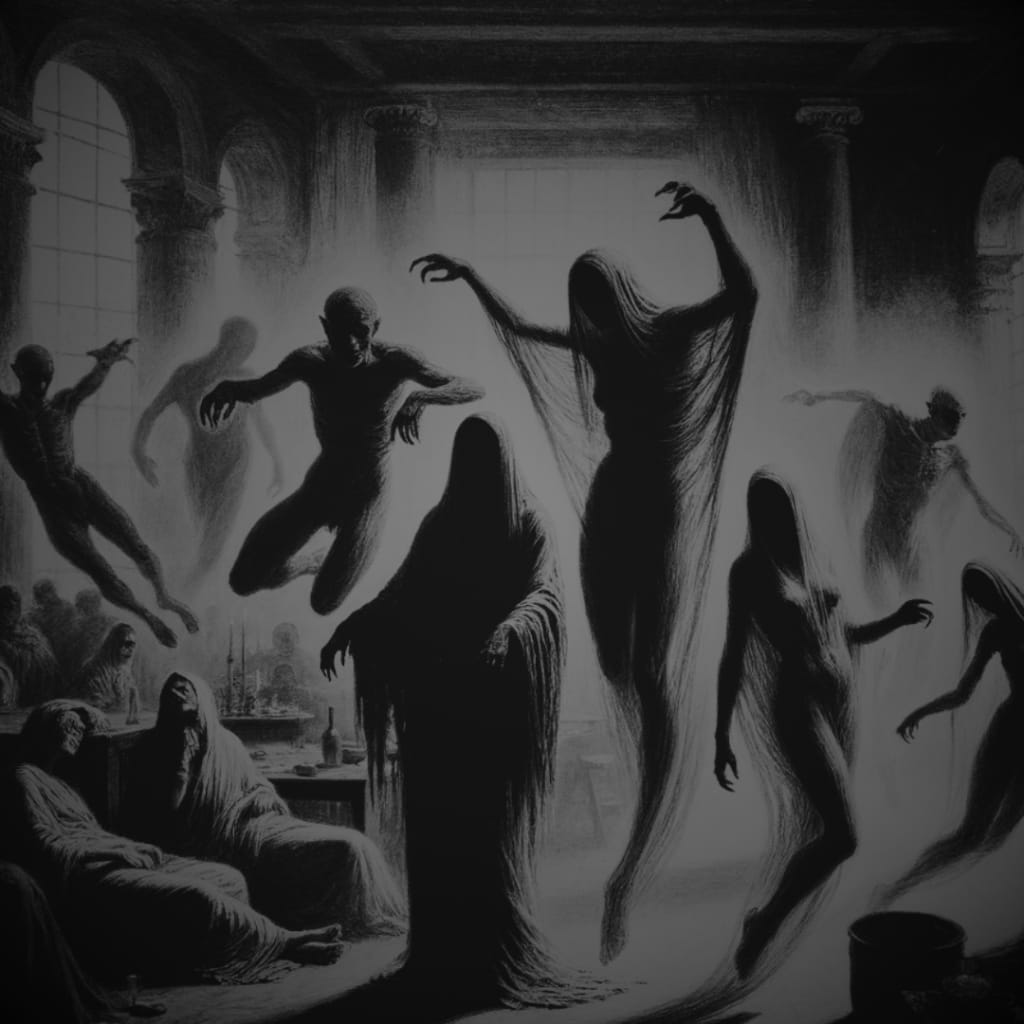Lemures of Ancient Rome
Vengeful spirits of Ancient Rome.

Ancient Rome is known for a lot of things: colossal achievements in architecture, governance, philosophy, literature, and the pantheon equivalent of Jerry Springer. With such a rich history in Ancient Rome, it's easy to overlook elements from their culture, like folklore. But, as with most cultures, folklore played a huge role in the daily lives of the Ancient Romans. Among the fascinating beings from Ancient Roman folklore were the Lemures. In 753 BC, nearly 2,800 years ago, the legendary King Romulus founded the Roman Kingdom and the city of Rome. Today, the word Lemures isn't well known, but the idea of it is still very much alive.

Lemur vs. Lemures
The name "lemur" derives from the Latin word "lemures," which means "ghosts" or "spirits." Carl Linnaeus, the so-called father of modern taxonomy, first applied this name to these animals in the 18th century. Some speculate Linnaeus chose this name because some qualities of the lemur animals were reminiscent of the Ancient Roman Lemures.
Lemur (the animal) is pronounced "lee-mr"
Lemures (Ancient Roman being) is pronounced "leh-MOO-rez"
To make it more confusing, the plural form of lemur is lemurs, and the singular form of Lemures is Lemure. For clarity's sake, I'm capitalizing the possibly deadly one from Ancient Rome everywhere in this article. Therefore, Lemure and Lemures will kill you and maybe drag you into the Underworld, but a lemur or lemurs might just maim you for some biscuits.
What Are Lemures?
In Ancient Rome, there was a concept known as "Manes"—essentially the deified, benevolent souls of deceased loved ones. On the opposite end of the spectral spectrum were the malevolent Lemures.

The physical description of Lemures is a bit of a mystery because they were mostly depicted as shadowy, formless entities rather than anything substantial. Ancient texts and folklore portrayed them similarly to how we think of ghosts.
Lemures were believed to be malevolent spirits of the dead, looking to cause harm to the living. They targeted households where they either had unfinished business or had wronged them. Like ghosts of today, Lemures were especially active at night. To make matters worse for the living, anyone who wasn't properly buried with funeral rites and revered by the living was at risk of becoming a Lemure. I'm sure that whole concept sounds familiar because it's the archetypal ghost story, embodying the supernatural, fear, and questions of morality and mortality.

To Ancient Romans, the Lemures were a serious problem because they haunted and tormented the living. The torment from Lemures could manifest in different ways, from the subtle psychological, like nightmares, to a more direct approach, like illness. And, unlike ghosts of today, there weren't really any skeptics of Lemures in Ancient Rome. They were so ingrained in the fabric of society that the Ancient Romans held an annual festival called Lemuria to try and deal with them.
What Was Lemuria?
Lemuria was a festival observed on May 9, 11, and 13. It was a unique event with significant meaning and reflected how Ancient Romans viewed the afterlife and the supernatural. According to the poet Ovid, the festival's origin can be traced back to Rome's founders, Romulus and Remus. Romulus started Lemuria (initially called Remuria) to appease his twin's (Remus) spirit after Remus's death.

For Ancient Romans, the entire festival of Lemuria centered around dealing with Lemures to prevent (or stop) them from troubling the living. The rites and rituals performed during Lemuria were similar to some that occur today worldwide.
Lemuria the Festival...Not That Other Lemuria
The word Lemuria is also the name of a continent that some believe sunk into the Indian Ocean. There's a theory that the continent of Lemuria was the origin of humans. You can explore more about the supposed lost continent of Lemuria here.
One Lemuria ritual, as described by Ovid, the head of each household would get up at midnight, walk barefoot, wash his hands with spring water, then take a handful of black beans and throw them over his shoulder or put them in his mouth and spit them out.

The beans were an offering to the Lemures and served as a form of protection for the entire family. The bean ritual was accompanied by a chant, repeated nine times: Haec ego mitto; his redimo meque meosque fabis. (Meaning: "I send these. With these beans, I redeem me and mine." While this was all happening, the rest of the family would bang bronze pots together and say: Manes exite paterni! (Meaning: "Ghosts of my fathers and ancestors, be gone!")
Bean Throwing
Interestingly, there are similarities between the concepts and rituals of Lemuria in Ancient Rome and Japanese Setsubun (節分) with its mamemaki (豆撒き) ritual. You can learn more about that here on TomokoOfficial's video What is SETSUBUN and how it is celebrated" in 1 minute - JAPANEWS #85.
The influence of Lemuria on the Ancient Romans extended beyond just the official festival days, and the whole month of May was considered unlucky for weddings. Lemures and Lemuria were a big deal in Ancient Rome—which sort of makes you wonder...what happened? And, if the whole point of Lemuria was to deal with the problem of Lemures, then what do people do about Lemures today?

We still don't know much about Lemuria or about many practices by the people of Ancient Rome, and we'll probably never get more detail than we have now because the beliefs were intentionally stomped out with the Christianization of Rome during the early 4th century AD.
The Christianization of Rome led to a gradual suppression of Ancient Roman religious beliefs and practices. The transition and subsequent suppression started in 380 AD with the Edict of Thessalonica, making Nicene Christianity the official state religion. It wasn't just the older Roman beliefs that were suppressed either, as other forms of Christianity were condemned as heresy.
The Edict of Thessalonica
In 313 AD, Constantine I and Licinius co-authored the Edict of Milan, granting religious tolerance across the Roman Empire. It was generally well-received and a huge step forward regarding religious freedom. Not long after, in 380 AD, the emperor Theodosius issued the Edit of Thessalonica, which was a massive step back in terms of religious freedoms and plunged the Roman Empire into a state of unrest with religious persecution and intolerance.
There were severe consequences for those who continued to practice anything other than Nicene Christianity. It wasn't just pagan practices; people of all sorts of belief systems were affected. People were systematically excluded from public offices and civic participation, effectively silencing their perspectives and voices. People had their property confiscated, fines imposed on them, and found it was impossible to do normal business. Temples were closed and destroyed, and festivals and sports were banned—all of this under the penalty of death.
It's kind of scary to think of a world like that, right?
Good thing we, as a modern society and in our advanced, peaceful, and enlightened world, have nothing like that.

Relevant & Related
- Captivating History has a short video, The Roman Empire Explained in 12 Minutes.
- Learn more about exorcisms and funerals in Ancient Rome with Catsual Storyteller.
- Check out even more about Lemuria with Hearth of Haemonia.
- If you're into history, and I know you are, then you'll want to put on this gripping documentary: The Complete History Of The Roman Empire | Empire Without Limit (Full Series) | Odyssey. I mean...gripping and documentary aren't two words you typically see together, but seriously, you'll love this one.
- For more about the Christianization of Rome, try Why Christianity went Viral in the Roman Empire by Tominus Maximus.
- Into archaeology? Don't miss Rome: An Oxford Archaeological Guide by Amanda Claridge.
- You can also read more about The Decline and Fall of the Roman Empire by Edward Gibbon.
- As for horror set in Ancient Rome, surprisingly, the pickings are slim. However, H.P. Lovecraft wrote a short piece titled The Very Old Folk, which you can read online.
- You may also want to try Worms of the Earth by Robert E. Howard, which combines Ancient Rome with Cthulhu Mythos.
- Oh, and also zombies in Ancient Rome in the novel Legion of the Undead by Michael Whitehead.
You might enjoy these other articles:
- The Vrykolakas of Greek Folklore
- Hydrus of Medieval Bestiaries
- Vântoase of Romanian Folklore
- Abbey of Thelema in Sicily, Italy
- Jure Grando of Kringa, Croatia
- Krampus of Alpine Folklore
- Nale Ba of Bengaluru, Karnataka, India
~
Originally published in my weekly newsletter, Into Horror History - every week, I explore the history and lore of horror, from influential creators to obscure events. Cryptids, ghosts, folklore, books, music, movies, strange phenomena, urban legends, psychology, and creepy mysteries.
About the Creator
J.A. Hernandez
J.A. Hernandez enjoys horror, playing with cats, and hiding indoors away from the sun. Also, books. So many books—you wouldn't believe.
He runs a weekly newsletter called Into Horror History and writes fiction.
https://www.jahernandez.com






Comments (1)
Another interesting article as usual.